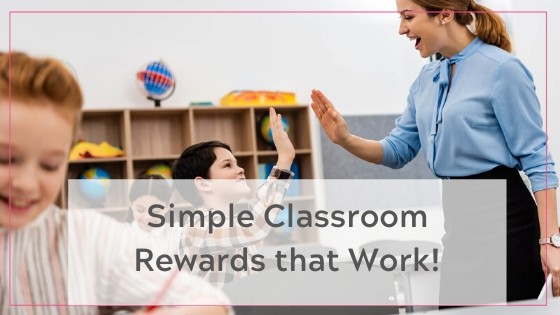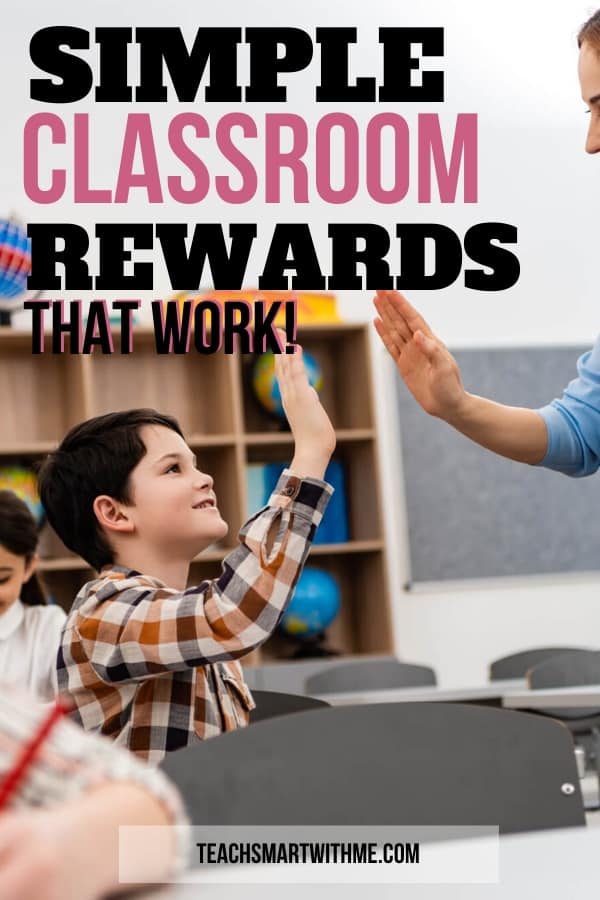Read to find out about simple rewards that can be built into a structured classroom rewards system that works well for primary age students.

Hey, there friend. I’ve talked about some pretty heavy topics lately, in particular, the back to school anxiety that affects some teachers.
But, I thought in this article, I’d discuss implementing a classroom rewards system to help alleviate the stress that you might have with this topic.
Some might be overwhelmed, particularly if you’re not sure what rewards to use, or you might just feel like freshening things up in your room.
Either way, this post is for you.
To use a classroom reward system or not?
There is some debate that questions the use of classroom rewards for children and the validity of using an extrinsic motivator like this.
But if you’re still deciding if you’ll use a classroom rewards system this year or continue with one, understand that research says that many teachers do use classroom rewards to motivate their students.
It’s because we know they work.
I honestly believe having a classroom reward system is a necessary part of a whole classroom management plan, which helps effectively manage my students’ behaviour and ultimately teaches them to make good choices at school.
If you’re going ahead with rewards, remember, you don’t need to complicate things, but a ‘make-it-up-as-you-go’ approach often won’t be as effective as if you plan it out.
Get access to the FREE Teachers’ Resource Library Here:
Keys for a successful classroom rewards system
This post discusses a rewards system especially for middle school students – grades 4 -6 – because that’s what I know best, plus it has worked really well for me for many years in my year 5 classes.
If you need more information about how a rewards system ties into your overall classroom management plan please read the article 12 Strategies for a Successful Classroom Management Plan that can help.
For now, I’ll describe the steps I use to implement my rewards system and I know it’ll work for you too.
The form you have selected does not exist.
Steps to implement your Classroom rewards system
Things to remember:
- Firstly have a clear and detailed classroom management plan in place – check!
- Know what sorts of rewards you want to use throughout the year (search Pinterest, websites or ask colleagues what they use) – check
- Know your timeframes for implementation throughout the school year – check
- Find the resources you will use – twinkl has some free printable sticker charts that I’ve used in the past
- Prepare resources preferably before the school year starts or before the term of implementation
- Purchase small prizes to add to a ‘prize box’ – use a variety of interesting little things – I find stationary does well (highlighters, fancy erasers, whiteboard markers, special pencils, etc), also provide little nic-nack items that suit both boys and girls. These can be purchased these from Dollar shops
- Teach goal-setting to your students – this works well in tandem with your rewards program and gives students a clear focus on what they want to achieve
- Give regular feedback to your students on their learning and behaviour
- Slowly phase out these extrinsic rewards as the year goes on and this will help develop more intrinsic motivations for students
Classroom Rewards to use at the beginning of the year
Individual student rewards
Term One rewards
I always start with an individual sticker chart or star chart for term one. I find at this age, students love stickers and they seem to have a magic power over them.
This strategy is used in conjunction with the clip-behaviour-chart where positive behaviours are rewarded by a sticker each day.
The stickers tend to flow fairly abundantly at the beginning of the year, so as to develop and encourage the behaviours and expectations that I am looking for.
Then as they mature over the term, their behaviours must be pretty good to get a reward.
Sticker charts are easy to prepare. I just photocopy a simple grid of approximately 20 sticker spaces for each student on pretty coloured paper. You can pretty it up or copy pre-printed templates. (I used to laminate them, but this ended up being a waste of time and expense – the coloured paper does just as well on its own).
Have the sticker charts ready to go for day one of school and after you’ve had a whole class discussion about classroom rules and the students are aware of your expected behaviour, they can start collecting their stickers.
When each student fills up all of these spaces on their sticker chart, they can then request a prize.
Then students continue at their own pace and everyone has the chance to collect a prize when their sticker chart is full.
Related Article: Clever Classroom Rules: Tips for Teachers
Term 2 rewards and beyond
For term two, I change things up, because I’ve found students get tired of stickers easily – maybe not so much in the younger grades, but for 10-year-olds and over, they get bored pretty quickly.
This is when I revert to a Class Economy system.
You could use classroom cash/bucks, tokens, coupons or tickets – anything students can collect and manage themselves.
I use colourful smiley face tickets that I laminate. Kids love these! (and if you’re clever and remember to collect the unused token from the students at the end of the year, you can reuse for the next year).
The tokens replace the stickers from term one.
These tokens are given for the same positive behaviours that are observed. The only difference, the students use the tickets to purchase a prize.
Note: When issuing tickets, to save time, I sometimes give the whole class a ticket if everyone has displayed great behaviour for the day.
Students collect their ‘tickets’ and when they have gathered the agreed amount to gain a prize (the goal in my classroom is 15 tickets), then they make a purchase.
I continue this economy system for the rest of the year.
As the year progresses, I’m not as generous with handing out the rewards. I expect that as students mature, they develop more intrinsic motivation for their good behaviour choices and work well done.
Special Classroom Rewards
It’s also good to have some other classroom rewards that you can use to develop the behaviours you wish to see.
I have a variety of other motivators that I use from time to time, depending on each class, but it’s always good to have these in my teacher toolkit.
Student of the Week
‘Student of the week’ involves choosing one student each week that had exceptional behaviour in the previous week. This student’s reward is a certificate and some special privileges. These privileges could include:
- being the teacher’s helper for the week
- answering the classroom telephone (this will depend on the maturity level of your students and phone etiquette will need to be taught beforehand)
- being line leader for the week
- being able to use a special cushion to sit on.
The ideas for these privileges are endless.
I’ve found this type of award to be very motivating for the class and they work really hard to be ‘student of the week’.
End of term awards
At the end of the term and in particular, at the end of the school year, I often choose students to receive special awards for certain behaviours. I love doing this because often students are not expecting it.
Awards to offer:
- most improved student
- most dedicated
- best at mathematics
- best reader
- most consistent with homework
Often, it’s so hard to just choose one student for each award, so you can always pick a few children that suits each category. The sky is the limit for these award certificates.
Don’t forget get the secret password here:
Rewards to encourage positive behaviours
To develop independence, I offer unexpected tickets called ‘Desk Fairy.’
I do this by secretly ‘spot checking’ students’ desks to see if they are keeping their belongings orderly and tidy.
A fun idea for this award is by making laminated ‘desk fairy’ notes. Once every so often, I quickly check each student’s desk at the end of a school day, and if it is neat and tidy, I leave the ‘desk fairy’ card.
This cute card invites the student to bring me their note to receive a small prize (often it’s a small piece of wrapped chocolate, like Favourites or Celebrations)
N.B. If they miss out on a card they learn pretty quickly to start keeping their space tidy.
I love this approach, as I don’t have to keep telling them over and over to keep their desks tidy, as they’ll now want to do this on their own and get a treat like their friends.
Tip: Just search ‘desk fairy notes’ on google and you’ll get the idea.
Whole-Class Rewards
Having whole class rewards can be a fun way to develop class unity, cooperation and belonging amongst your students.
Whole class rewards are determined as a medium-term goal for the class to achieve. The trick is to only give them a reward if they have achieved the goal.
It won’t work if you give in to them when it hasn’t happened yet. (This, I insist on). Be strong! it pays off with consistent whole class behaviour.
You’ll also need to decide with your class how they can achieve their goal.
Whole-class required behaviours
What behaviours are you looking from the whole class?
You might discuss with them to achieve steps forward, they’ need to:
- walk to and from other classrooms quietly as a whole class
- work well together for other teachers when you are not there
- work well as a whole class in assessment time or reading rotations
- when you use an attention-getter, the whole class needs to stop and be attentive altogether
- work well in group-work activities
- Anything they do together as a class
Just have these decided beforehand and make sure your students are aware of how they can achieve their whole class goals.
Whole-class strategies
There is a great variety of strategies you can use to implement your whole class rewards, so I’ll list a few ideas for you:
- Marbles in the jar – this is my favourite and is achieved by adding marbles to a jar, as great whole class behaviours are observed. When the jar is full, a reward it then issued. I give them approximately 5 weeks to complete this.
- Mr Potato Head – similar to the marbles, Mr Potato head starts off with no features. As the whole class behaviours are achieved, the teacher adds a piece to his body. A fun and visual way for students to see their progressive results. When Mr Potato Head has all of his parts, they achieve their reward
- Monkeys in the Barrel – Use the old game pieces to show the progression of the class goal. As behaviours are observed, add a monkey piece by hanging each of them from the other. This can be set up from a fixed point in the room (maybe the top of a door or ceiling).
Once your class has achieved their goal, you can jointly discuss what their prize will be.
We discuss these outcomes in our regular class meetings and we’ll be quite democratic about the whole process. The chosen reward is then worked into the term.
Ideas for whole-class incentives
- class parties
- a movie and popcorn session
- board games
- pyjama days
- crazy hair day
- time on the school playground equipment
- outside games afternoon of their choice e.g. softball, capture the flag, soccer, games on the tennis court etc
All these are at the discretion of you as their teacher.
Last words about this classroom rewards system
You can see this simple classroom rewards system can work very well, but there needs to be some planning with it and then you can just set it and forget it from year to year.
It cleverly combines a balanced approach of rewarding both individual and whole-class positive behaviours, which works so well for primary students.
My kids love this system and I hope yours will too.
PIN IT FOR LATER!

Michelle x


Leave a Reply